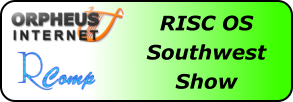Seven months on? This must be some kind of a record!
The RISC OS Southwest Show this year took place on 25th February – so this show report sets quite a record for the time between the event and its appearance at just under seven months. Unfortunately, this is a reflection of the amount of time I’ve had available in that intervening period to sit down and write the report. Which is to say: very little.
To make matters slightly worse, I usually refer to the photos I’ve taken at the show as a means to remind myself of who was there, what they were demonstrating, and so on – and this year, I forgot to take my camera. I did take a few pictures with my phone, but I really don’t like my phone as a camera (it’s perfectly capable, it’s just the way it has to be held, etc.) and therefore only have a few pictures.
So before I even begin to start writing, I should say in advance that this report will probably turn out to be a bit short, and lacking in any real detail – and some exhibitors may get missed out. I apologise in advance for this.
On the upside, however, rather than the usual ‘mobile theatre’, this year an area was set aside for the various talks. This meant it was practical for me to record them – something I am usually unable to do at the Southwest Show. The videos are already on YouTube – as mentioned on the Shows and Events mailing list back in April – and will be embedded below at the appropriate points.
The hall was laid out in a similar manner to last year, with the public space forming a ‘U’ around the hall, and the exhibitors being placed around both sides of that ‘U’ – so I will (attempt to) follow the left for the purposes of this show report, starting with the inside of the ‘U’.
North One Communications
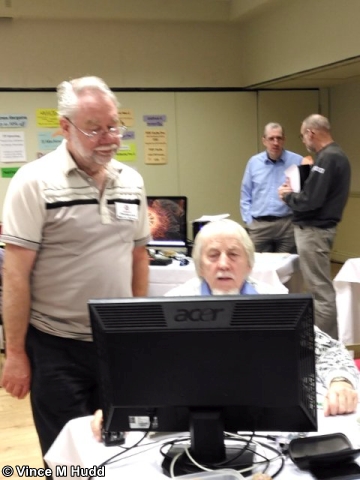
The first exhibitor on this route was North One Communications, where the most recent edition of Organizer – the, no THE – personal information manager for RISC OS was available. On hand to discuss the software were both Martin Avison and Cut-me-own-throat Dibbler Nigel Willmott (who, it has been pointed out to me, I occasionally call Nigel Gatherer – an entirely different person. Sorry Nigel. And Nigel).
Version 2.26 of Organizer was being demonstrated and sold, which features the ability to require a password to use the software, and independently of this offers the option to encrypt data – an increasingly important requirement as use of ‘cloud’ services increases.
Orpheus Internet
One half of the Dynamic Duo that organises this event was next, with Richard Brown representing the RISC OS-friendly ISP, Orpheus Internet.
Orpheus was originally formed over ten years ago by the late Paul Vigay, as a replacement (of sorts) for Argonet, an ISP that got a many RISC OS users online with its easy to set up and use Voyager Internet Suite. Argonet moved on, but the customers still wanted to be able to access the internet – so Paul, who worked for Argonet at the time, stepped in to facilitate that. The way people access the internet has long since changed – back in the Argonet days, it was typically using a dial-up modem, but Orpheus continues to provide access with broadband packages, as well as hosting facilities, and more.
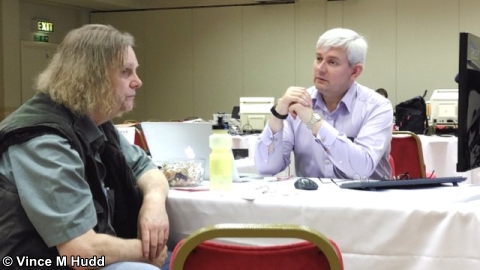
Visitors to the Wakefield Show, which took place a couple of months later, had the opportunity to listen to Richard talk about a new company, RISC OS Developments, and (subject to signing an NDA) find out what the company’s plans are. The seeds for that were being sown at the Southwest Show, when Richard approached exhibitors to discuss his idea, which itself stemmed from something asked by a user. So, although it’s a video from the Wakefield Show rather than the Southwest one, here is the talk Richard gave at Wakefield:
(Speaking of the Wakefield Show, I still need to watch and edit the full set of talks from the Wakefield Show – so the show report itself will have to wait until I have done that. Hopefully, I’ll be able to get onto those in the next few weeks.)
Soft Rock Software
Next to Richard, I was manning the Soft Rock Software stand. At least, I was when not wandering around the hall, or tending to the video camera and portable amplifier in the show theatre.
As ever, I was mostly showing off and talking about things that weren’t actually on sale; things that are either on the Soft Rock Software website as a free download, or aren’t yet but “I’m working on.” A good example of this being my old budget games, originally released between 1990 and 1994. These are currently unavailable, but I am planning to change that “soon” (ahem!)
I am also working on rewriting and updating them, so that they not only work better on newer hardware, but also benefit from some of the features of that new hardware – such as high definition graphics. To that end, while no real programming has been done, one of the games people could play on my stand was a version of Escape from Exeria ‘hacked’ to run with newer graphics, and new levels.
Again, although not the show itself, here is a recording of the modified game being played:
Chris Hall
Often benefiting from a corner of my table, a last minute decision was made this year for Chris to have his own table – and when I say last minute, if memory serves it was decided on the morning of the show, as exhibitors were starting to set up. You can get much more last minute than that!
Chris had his portable Raspberry Pi-based units on display, running SatNav. The software interfaces with a GPS unit to determine its current location and, when run in a full desktop environment it can talk to RiscOSM, displaying that location on a map.
Steve Fryatt
Next to Chris, Steve Fryatt was demonstrating his range of software, including grumpy (because it’s got the hump) home accounts package CashBook, and much more besides. As usual, the software was available to buy on CD, with the proceeds being given to charity.
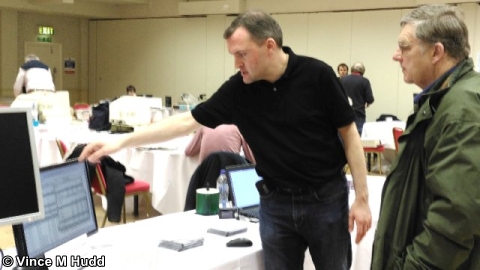
Archive Magazine
There was reading material next, in the form of the Lesser Spotted Archive. Editor Jim Nagel was taking subscription renewals, or telling people why they should subscribe in the first place. He was also taking advance orders for the next edition of the Archive magazine CD / DVD, work on which is underway.
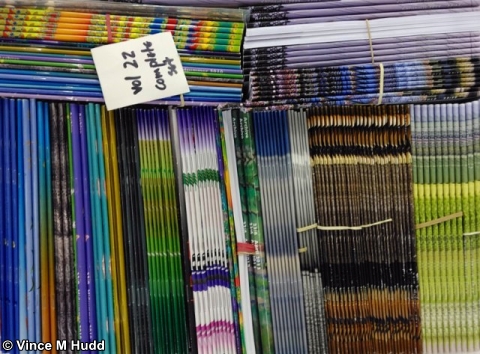
There wasn’t a new issue of the magazine itself published to coincide with the show, though, because Jim had decided to hold it back to add any last minute news. It’s typical – and not particularly helpful – for most show-related announcements to come out within the last week or so before the event takes place. It’s hard enough for an online news outlet like RISCOSitory to deal with last minute announcements, and much harder for someone trying to publish a printed magazine – it leaves no sensible time frame to get the magazine printed.
That said, there is an argument that it may have been better to publish a smaller edition without waiting for the show-related news – especially given how infrequently the magazine now appears – so it’s very much a case of swings and roundabouts.
Charity stand
Moving from the inner part of the ‘U’ to the outer part, the charity stand was next, where all manner of things were available to buy – some old, some less so, and some related to RISC OS, some less so!
I was given details of the amount raised, etc, at the end of the day – which I am absolutely positive I made a note of in my phone. However, all these months later, I can’t find that information. I’ve sent an email to Moss (one of those running the charity stand), so if I hear back I’ll update this accordingly.
CJE Micro’s and 4D
Purveyors of everything but the kitchen sink, CJE Micro’s and 4D had the next stand. Chris Evans and Andrew Conroy had, as ever, squeezed an awful lot of stuff into their vehicle to bring to the show – and I hope they managed to sell some of it, because I’d arranged with Chris to pick up a BBC Master for them on the way to the show. It was all boxed, and complete with its CRT monitor, and the result was a tight enough squeeze in my car with my own stuff, and I bring considerably less!
Their more general stock includes of everything from the smallest of spare parts all the way up to complete systems, old and new – and in particular, the they like to highlight the RapidO Ig and Ti computers, which are based around the IGEPv5 and Titanium boards respectively.
In addition to these, there were a couple of new – 4D – items launched at the show. The first was a 3 button serial mouse, suitable for use with Acorn computer systems; a handy alternative to the ‘native’ version, which have not been made for many years and are hard to come by. And the second was a Wacom Graphics Tablet, with a driver suitable for use on computers running RISC OS 5.
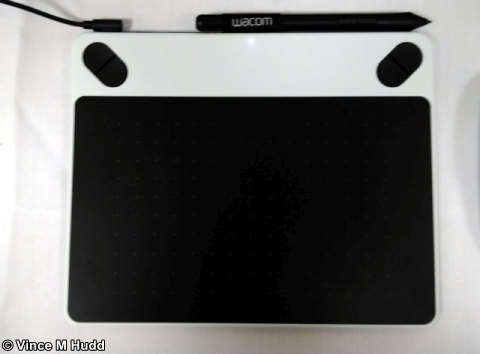
Chris gave the first talk of the day, in which he talked about both of these and much more:
Being the first talk of the day, Chris was using (or trying to use) the microphone and sound system provided by the hotel, and was having problems. I’ve edited out most of the results of this, except where necessary for actual content.
David Snell
A regular exhibitor at the Southwest Show, David Snell was again present with his range of software, including ProCAD+, a versatile computer aided drawing package with a large range of features and a wide range of applications and possible use cases – from designing the layout of a living room, to designing the house itself, or for designing printed circuit boards, wiring diagrams, and so on.
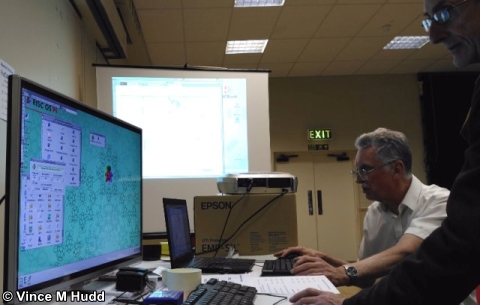
David also sells an add on for ProCAD+ called ProOSM+, an OpenStreetMap file interpreter for ProCAD+ which results in the map data being converted into a fully editable ProCAD+ vector drawning.
John Norris
Once again, the show’s centrepiece was tucked away in a corner, in the form of John Norris and his campanology set up – a papier maché (and therefore just about silent) bell, mounted in a tall wooden frame for people to try their hand at bell ringing.
Wait, what? How do you ring a bell that makes no sound?
Easy! There is a sensor attached to the frame that detects the bell’s motion, and feeds that information to a computer. The computer, running John’s ‘Stringing’ software, then produces the bell sounds, just as a real bell would – except this approach allows the campanologist to use a set of headphones, and thus to practice their hobby without disturbing anyone else.
Turning his hand to building something a little smaller, John has also produced a couple of ‘laptop’ solutions based around the Raspbery Pi and a briefcase – the first version of which debuted at the 2013 show, and was christened ‘Pi in a Box’ by a visitor.
The design has now been improved upon, however, and there is now a second version – both of which were on display at the event.
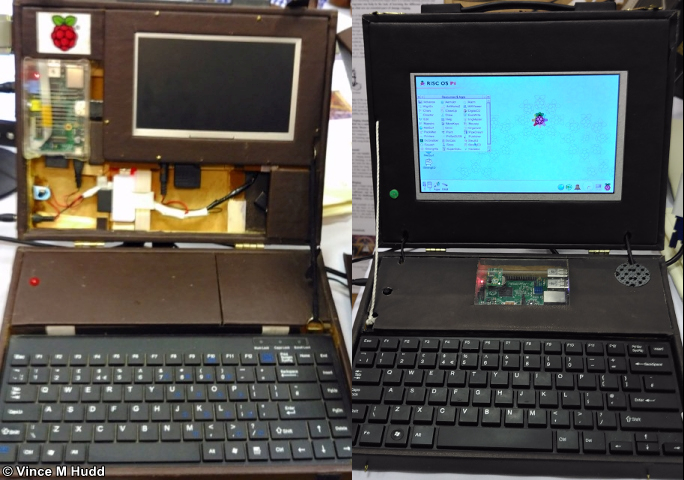
Tasty Treats
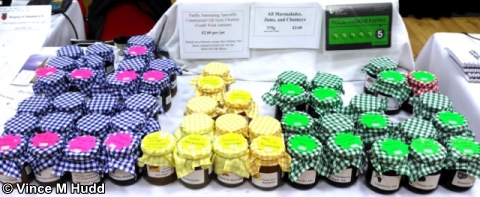
For anyone who doesn’t attend the RISC OS Southwest Show the association RISC OS has with jam is that RISC OS is available for the Raspberry Pi, and the Pi community organises events – some regular, some less so – called Raspberry Jams.
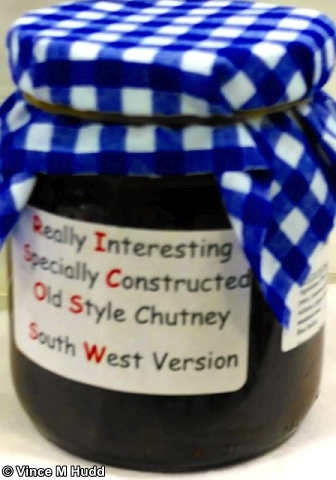
However, for those who do attend the Southwest Show, another association RISC OS has with jam is that Mary Norris, John’s wife, makes a nice line of jams (and chutneys), which she brings along to the show each year.
Mary produces her jams and chutneys under the name Tasty Treats – a very appropriate name, because the jams are indeed tasty, and it is therefore a treat to have some on toast of a morning. No surprise, then, that I bought a few jars for my own toast.
And this year, there was a more notable RISC OS connection, in the form of a “Really Interesting Specially Constructed Old Style Chutney – South West Version” – or RISC OS SW for short!
RISC OS Open
Ben Avison and Rob Sprowson were manning the RISC OS Open stand, with the customary array of goodies available to buy – the latest development tools, pre-configured SD cards ready to boot your Raspberry Pi into RISC OS, the Nut Pi collection of software for the Pi, and more.
There was a Titanium-based system on the stand demonstrating one of the current works in progress for RISC OS: dual headed output. There were two displays connected, with the RISC OS desktop spanning them.
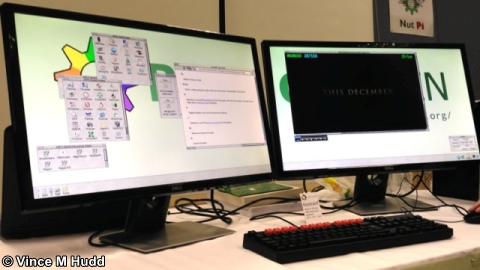
The ROOL stand also featured a robot arm (not ARM), controlled from a Raspberry Pi running RISC OS, and visitors were challenged to test their dexterity by controlling the arm from a keyboard, to pick up and stack a couple of small cubes. I don’t know about anyone else, but I felt the most efficient approach was use the dexterity of my own arm, hand and fingers – but that, apparently, was cheating.
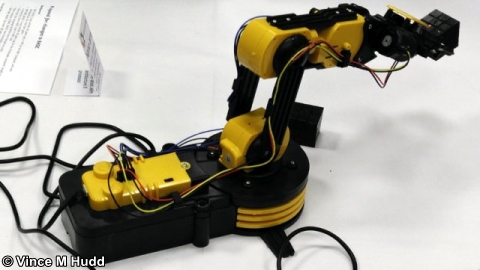
As ever, one of the theatre presentations was ROOL’s. The talk was given by Rob, who covered what the company has done since the same time last year, and what it is currently looking at, as well as the bounty scheme and how users can get involved and help.
AMCOG Games
With an ever increasing number of games under his belt, Tony Bartram was next on the AMCOG Games stand with all of his titles available individually, or as part of a compilation. As well as the games, Tony was also demonstrating his RDSP module and showing off (or should that be sounding off?) its capabilities, and the improvements it brings to the sound system present in RISC OS computers.
Tony’s space was immediately before the corner area set aside for the show theatre – which was handy, because he also gave one of the day’s talks, in which he showed off the various games, and gave a detailed explanation of what RDSP is and what it does.
RISCOSbits
Moving on from ‘fun and games’ on thanks to AMCOG, the next stand was home to ‘fun in names’ thanks to Andy Marks and RISCOSbits. A new product on display at the Southwest Show was Wispy which, in keeping with RISCOSbits’, shall we say, “naming conventions” was pronounced “Whizz-pee” (or possibly “Why-Spy” but that’s less fun).
Wispy takes the form of an internally mounted ethernet bridge that is fully configurable from RISC OS, and uses a VNC connection to allow the use of Firefox – not the ancient RISC OS port, but an up to date Linux build. This then opens up more of the world wide web to RISC OS users, with a great many websites not being fully functional through NetSurf. The Firefox ‘downloads’ folder is, by default, available through OmniClient, so files downloaded with Firefox for use on RISC OS are accessible, but others can be set up.
Ident
Next to Andy, Tom Williamson was manning the Ident Computer stand with the Micro One – a system based around the Raspberry Pi with a fully licensed copy of RISC OS 5, housed in a case with an integrated keyboard, reminiscent of the home computers of the 1980s. The system comes in kit form – so you need a bit of glue, but no used washing up liquid bottles, pipe cleaners, or sticky back plastic – and there is a choice of three ‘trim’ colours: Red, Green, or Blue.
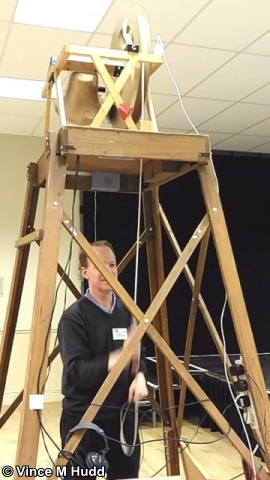
ROUGOL
The RISC OS User Group of London was, as ever, represented by Bryan Hogan, encouraging visitors to the Southwest Show to consider travelling once a month (or even just the once) to attend the London group’s meetings, which usually feature a guest speaker and an interesting topic.
Bryan was also reminding people that this year’s London Show will be taking place on Saturday, 28th October, at the St Giles Hotel, Feltham – another trip RISC OS users should consider making.
The ROUGOL stand was also another good choice for users who want to try their hand at a bit of gaming, with classics such as Zarch and Elite available to play, both running on a Raspberry Pi ADFFS from Jon Abbott’s Software Preservation Project..
R-Comp and R-Comp Interactive
The final stand – sort of, anyway – was R-Comp‘s, where a range of hardware and software was available to see and buy.
R-Comp’s flagship hardware product is, of course, the ARMX6 computer, and shortly before the show this received a couple of significant upgrades – a new network driver, bringing with it increased throughput of the network interface, and support for partitioning hard drives, allowing more of the space to be accessible from RISC OS that would have previously been unavailable.
Additional hardware available from R-Comp included Titanium-based TiMachines, a very nice curbed monitor, the RISCBook Go, and more, and software available from the company included the latest versions of backup software SafeStore, recycler DeleGate, amongst many other things.
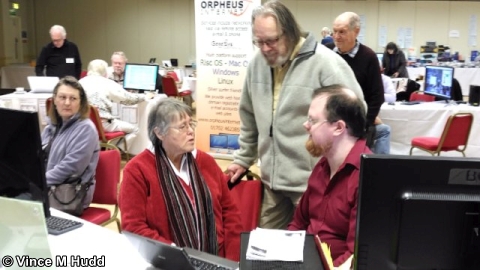
Andrew also gave one of the day’s theatre presentations:
Why did I say R-Comp’s was “Sort of” the last stand? Because a last minute discussion, prompted by a comment from a third party, resulted in a table being set aside by the exit as a congregation point for anyone wishing to arrange shared transport from the venue to railway stations, etc. Transport is often cited as “an issue” with the Southwest Show because the venue, although it’s a very nice hotel, is somewhat out in the sticks, and not well served by public transport. In fact, it was the same comment and discussion, and the apparent success of introducing the idea at the show, that led to the creation of the Shows and Events mailing list shortly after the event. Amongst other things, this can be used to provide a forum for people to make arrangements for lifts and shared taxis in advance of other RISC OS shows.
That wasn’t the only show innovation – another fairly last minute addition (though the original idea was discussed prior to the previous year’s show) was a feedback form, designed to get an idea not only of what visitors thought of the show, but also how far they travelled and how they got to the event, amongst other things. However, the results of this are unknown to RISCOSitory at this point – as are the number of actual visitors through the door. As with the charity information, I’ve fired off an email asking of the numbers and results – and will have to update this post (or post some kind of follow-up) if the information comes my way.
So that is the better late ridiculously late than never Southwest Show report! Next up, Wakefield – that took place approximately two months later, so if I can get it written before the London Show takes place, it won’t be quite as late as this one!



